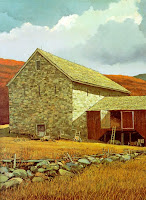I think we can all agree that the U.S. needs to reduce its dependence on foreign energy. Increasing our energy independence will entail a combination of the wise conservation of existing sources while exploring alternate sources. It will include both personal behavior and government involvement. There is no panacea.
Here in Maine, wind power has become a very controversial issue. Governor Baldacci has declared the development of wind power a priority of his administration and in this State, what the Governor wants, the Governor gets. He has expedited the permitting process for industrial wind projects by eliminating certain requirements. Maine currently has 18 industrial wind projects either online or at some stage of approval.
But let's pull in the reins a minute. Maine is known as "America's Vacationland" because of its unspoiled natural beauty. Many of us have bought or built cabins in pristine areas as an escape from urban lights, noise and traffic. We love the land and respect nature. Clear-cutting the mountain tops and ridge lines to erect 400' tall industrial wind turbines would do irreversible damage to Maine's greatest asset, its pristine beauty. Why are we rushing into it?
There is plenty wrong with the way Maine has charged ahead toward the Governor's stated goal of becoming "the Saudi Arabia of wind" but rather than explain how ill-conceived his plan is, I'm going to take a more positive approach. I want to present a quick list of questions that should be asked and answered before any industrial wind project is approved.
1) Does the site make sense? The government has completed extensive and detailed studies of wind levels across the country. The resulting maps can be seen at:
www.windpoweringamerica.gov/wind_maps.aspand
http://rredc.nrel.gov/wind/pubs/atlas/
2) Zoning. Is the site in an area zoned for industrial development or will zoning variances have to be granted?
3) Who's behind the project? Is it a public- or a private sector project? If it is private sector, we need to keep that in mind at all times. Who are the backers and what are their motivations?
4) Does it make financial sense? The project needs to make both short-term and long-term financial sense. If it's private sector, does the developer have sufficient capital? Will it be profitable? More importantly, would it be profitable without any taxpayer money going into it in the form of subsidies, tax advantages or other preferential treatment from local, state and federal government?
5) Are the projections valid? If the investors claim they will be profitable, are their projections based on realistic data? Every figure must be questioned and defensible. The burden of proof must be on the project's backers. Is there a ready buyer for the power generated? If so, is the projected sited near existing delivery lines that can handle the additional capacity?
6) Local impact. What impact will the project have on the environment, local economy, and the health of nearby residents? How many permanent jobs will be created? How will nearby property values be affected? Hard facts and trustworthy studies from existing projects are now available.
7) What impact will the project have on the current grid? Will the responsibility for building new grid capacity fall to the citizens? What impact will the addition power lines have?
8) Study the developer's reputation. Are there allegations of improper dealings associated with other projects? Any history of lawsuits or indictments? Have its other wind projects met their power-generating objectives?
9) Scrutinize those in favor. Which supporters have a financial stake in the project? Which ones have a less direct vested interest in it? Which ones support it because they believe "wind is green so wind is good"? Which ones intelligently back it only after careful consideration of the short- and long-term costs and benefits?
10) Scrutinize those against. Which opponents are against the project because they don't want it in their back yards (a.k.a. NIMBYs)? Which ones intelligently oppose it only after careful consideration of the short- and long-term costs and benefits?
11) Scrutinize the decision makers. This would be the officials of affected towns, the State DEP, Corps of Engineers, and others. If any individual with a vote in any stage of the approval process has any kind of relationship or stake with the project's developer, ethics demand that he declare that relationship and recuse himself.
12) Is it a net green gain? Setting aside the political and financial issues, will this project be a net gain in terms of 'going green'? Keep in mind that fossil fuels are used to start and stop the blades. Turbines also consume enormous amounts of grease and oil for lubrication and cooling. When the power generated is forced into the existing grid, the traditional power plants will by law have to throttle back and operate less efficiently, thereby creating more pollution.
13) What if the wind doesn't blow? Should the project fail to deliver as projected, will the developer be required to remove the towers and return the land to its pre-project condition through soil replacement and planting? If the developer has confidence in his projections, writing such a clause into any permit should not be a problem. If he refuses, consider that a red flag!
Well, that's my quick & dirty list. Before you ask, no, my cabin is not threatened directly by any industrial wind project. Yet I feel very strongly about the irreplacable value of a clean lake and a wooded ridge line whether it's outside my window or not. I'd just like to see wind projects subject to thorough, open, honest and ethical evaluation. Is that too much to ask? Let's not rush like lemmings to the cliff.












